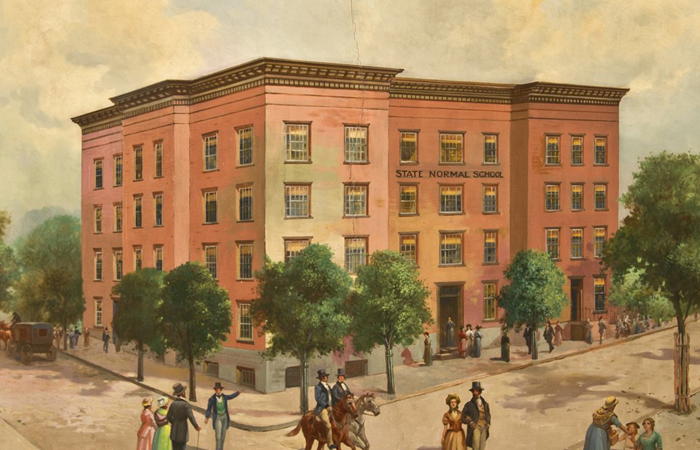Collections : [University Archives]
University Archives
Records that document the history of the University at Albany, SUNY and its predecessor schools.
Search Constraints
Start Over You searched for: Collecting Area University Archives Remove constraint Collecting Area: University Archives Date range 1916 Remove constraint Date range: <span class="single" data-blrl-single="1916">1916</span>Search Results
Project Cirrus, 1891-1985, Undated 4.25 cubic ft.
This series documents the Project Cirrus program, a weather modification initiative undertaken by GE along with the United States Signal Corps, Office of Naval Research, and the United States Air Force, with general oversight handled by the Department of Defense. As part of the effort, Dr. Vonnegut discovered that AgI, Silver Iodide, was a superior nucleation agent. This discovery significantly influenced the science of artificial precipitation and this method came to be adopted as the chief means of "rain making".
Biographical Files, 1875-1984 1.6 cubic ft.
This series contains papers pertaining to Robert Rienow and his family. Included are Rienow's military records from his World War II service in the United States Army and from the New York National Guard. These include discharge papers, appointment papers, immunization records, correspondence and memos. Also found in this series are legal documents and financial records from the estate of Rienow's uncle in Wisconsin, Fred Rienow. Rienow's education is documented through class notes and papers from West Point and from Columbia University, where he completed his Ph.D. There are several folders of brochures, news clippings, and souvenirs from Rienow's travels, including trips to Europe and the Midwest.
Robert Rienow Papers, 1875-1984, bulk 1955-1979 15.72 cubic ft.
Commencement Programs Collection, 1857-2019 2 cubic ft.
Melvin Urofsky Papers, 1850-1978, bulk 1870-1940 14.83 cubic ft.
Department of Physics Records, 1915-1971 2.0 cubic ft.
Duncan Blanchard Papers, 1789-2003 35.8 cubic ft.
Manuscripts, 1789-2003 9.8 cubic ft.
Series 1 contains materials Dr. Blanchard published while at Woods Hole Oceanographic Institute and the State University of New York at Albany as well as after his retirement. The topics covered by these publications include the history of science, water-to-air transfer, aerobiology, sea salt aerosols, volcanic electricity, and surface charge. There are also materials covering his studies of bubbles, water droplets, and rain. Along with his scientific publications, Dr. Blanchard also wrote letters to editors, comments and replies to articles, book reviews, obituaries, and autobiographical articles. Dr. Blanchard published materials from the early 1950s to the early 2000s but the majority of materials in are from 1960s, 1970s, and 1980s.
Financial Secretary Records, 1844-1965 15.2 cubic ft.
Cash Books, 1844-1965 4.8 cubic ft.
Contains a variety of cash books and ledgers: account ledgers, cash receipts for room and board, inventories, and library circulation statistics.
General Electric- Non-Project Cirrus, 1891-1993 21.0 cubic ft.
The research laboratory at General Electric was the launching pad for some of Vincent Schaefer's most pivotal scientific work. This series contains research notes, photographs, reports (published and unpublished, internal and external), and correspondence relating to all of his more famous experiments as well as a range of lesser-known work accomplished during his years at the G.E. Research Laboratory in Schenectady. The materials cover topics such as smoke/artificial fog generation, surface chemistry, studies of ice and snow particles, and early cloud seeding. The series is divided according to areas of specific interest to Schaefer as well as correspondence and publications.
Vincent J. Schaefer Papers, 1891-1993 135 cubic ft.
The formation and behavior of snow and ice crystals were a lifelong interest of Schaefer's, and in his time at General Electric he was able to focus on the subject during the World War II years as ice related to the safety of U.S. Air Force planes. Schaefer and Irving Langmuir's interest in that topic grew as a result of their World War II-era contract work with the military, and the experiments they conducted after the war's end led directly to their Project Cirrus contract in 1947—an undertaking so extensive that their work in that area merited its own series in this collection. Much of their foundational work in snow and ice composition and behavior was grounded in observations and experiments conducted on Mount Washington in New Hampshire. Schaefer discovered during this time that ice crystals and snowflakes could be captured and observed using Formvar plastic. Using this method, he documented very specific data about ice and snow before creating some of the first replicas of specific snowflake shapes. The work of Schaefer and his colleagues regarding ice research includes handwritten notes, drawings, charts, photographs, reports, and correspondence specific to ice, snow, and Mount Washington.
